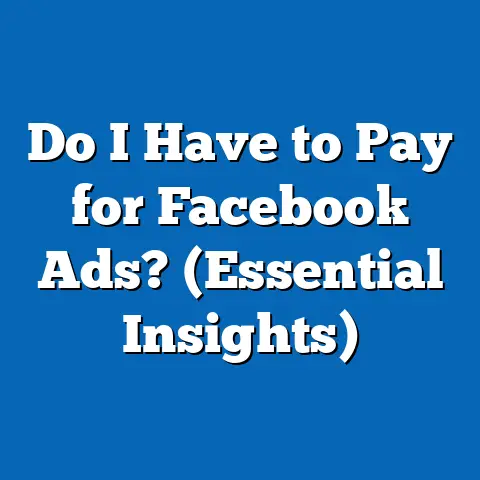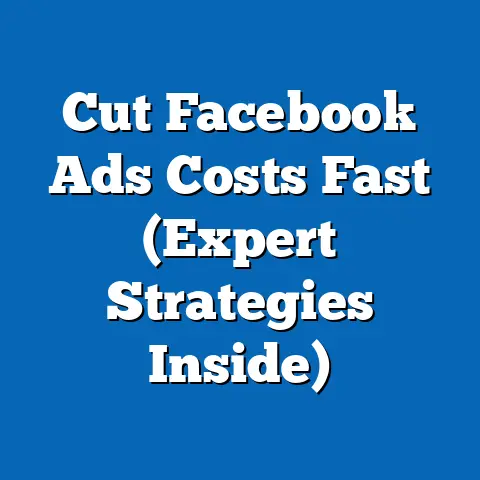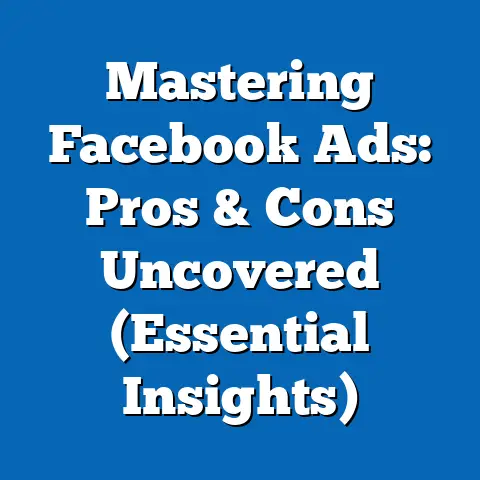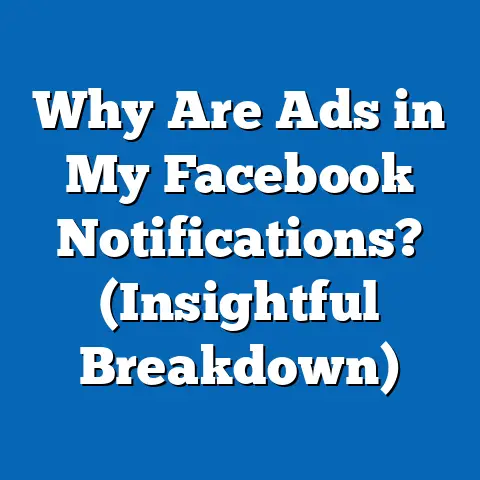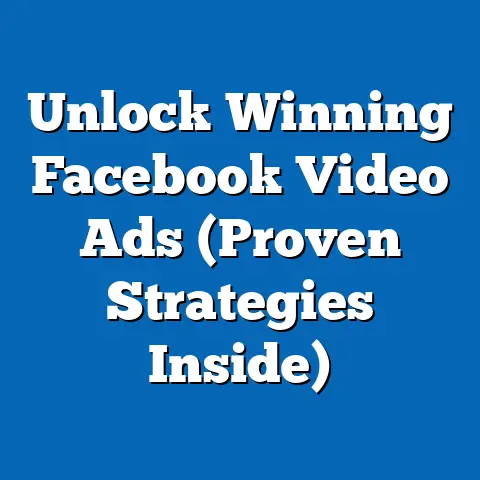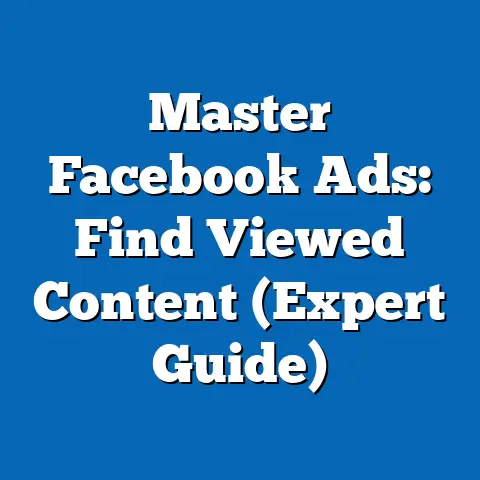Fix Facebook Ads (Expert Strategies for Success)
I’ve been in the digital marketing trenches for over a decade, and if there’s one thing I’ve learned, it’s that Facebook advertising is a beast. It’s a powerful beast, capable of delivering incredible results, but it’s also a complex, ever-changing beast that can easily devour your budget if you’re not careful. I’ve seen countless businesses, big and small, struggle to get the ROI they deserve from their Facebook ad campaigns. That’s why I’m writing this guide – to share the expert strategies I’ve developed over the years to help you fix your Facebook ads and achieve the success you’re looking for.
In today’s digital marketing landscape, Facebook advertising is an essential tool for reaching a massive audience and driving meaningful results. With billions of active users, Facebook provides unparalleled opportunities for businesses to connect with potential customers and build brand awareness. According to recent statistics, Facebook remains one of the most popular social media platforms, with over 2.9 billion monthly active users as of 2024. This vast user base makes Facebook an attractive platform for advertisers looking to expand their reach and engage with a diverse demographic. Moreover, Facebook’s advertising revenue continues to grow, indicating the platform’s effectiveness in driving conversions and generating ROI for businesses.
However, many marketers face significant challenges when it comes to Facebook advertising. High costs, low conversion rates, and ad fatigue are common issues that can hinder campaign performance and impact overall ROI. With increasing competition in the digital advertising space, it’s crucial to adopt effective strategies and best practices to optimize Facebook ad campaigns for better results.
Section 1: Understanding the Facebook Ads Ecosystem
Before you can even think about fixing your Facebook ads, you need a solid understanding of how the entire ecosystem works. It’s like trying to repair a car engine without knowing the difference between a spark plug and a carburetor.
The Facebook Ads Manager is your command center. It’s where you create, manage, and analyze your campaigns. Think of it as the cockpit of your advertising plane. Understanding its layout and features is critical.
A Facebook ad campaign is structured like this:
- Campaign: This is the highest level, where you define your overall objective (e.g., brand awareness, website traffic, lead generation, sales). I always start here by asking myself, “What am I really trying to achieve with this campaign?” Be specific.
- Ad Set: Within each campaign, you have ad sets. Ad sets control your targeting, budget, schedule, and placement (where your ads appear – Facebook, Instagram, Audience Network). This is where the magic (and the potential for mistakes) happens.
- Ads: Finally, within each ad set, you have individual ads. These are the actual creatives that your audience sees – the images, videos, and text that you hope will grab their attention.
The Importance of Understanding Your Target Audience
Facebook’s strength lies in its unparalleled targeting capabilities. You can target people based on demographics (age, gender, location), interests (hobbies, pages they like), behaviors (purchase history, online activity), and more. But, and this is a huge but, all that targeting power is useless if you don’t know who you’re trying to reach.
I’ve seen countless campaigns fail because marketers made assumptions about their audience. They thought they knew who their ideal customer was, but they were wrong. Do your research! Use Facebook Audience Insights, analyze your existing customer data, and talk to your customers directly. Ask them about their needs, their pain points, and what motivates them.
The Facebook Algorithm: Friend or Foe?
The Facebook algorithm is a complex beast, constantly evolving to prioritize content that users find engaging. Understanding how it works is crucial for getting your ads seen by the right people.
Here are a few key things to keep in mind:
- Relevance: Facebook prioritizes ads that are relevant to the user. The more relevant your ad, the higher it will rank in the auction and the lower your costs will be.
- Engagement: Ads that generate high engagement (likes, comments, shares) are more likely to be shown to more people.
- Ad Quality: Facebook evaluates the quality of your ad based on factors like image quality, text clarity, and overall user experience. Low-quality ads will be penalized.
Choosing the Right Ad Format
Facebook offers a variety of ad formats, each with its own strengths and weaknesses. Choosing the right format is essential for achieving your campaign objectives.
- Image Ads: Simple and effective for driving awareness and traffic. Use high-quality, visually appealing images that grab attention.
- Video Ads: Highly engaging and great for storytelling. Use short, attention-grabbing videos that showcase your product or service.
- Carousel Ads: Allow you to showcase multiple products or features in a single ad. Great for e-commerce businesses.
- Collection Ads: Offer an immersive shopping experience for mobile users. Ideal for showcasing a curated collection of products.
Takeaway: Understanding the Facebook Ads ecosystem is the foundation for successful advertising. Take the time to learn the ins and outs of the Ads Manager, research your target audience, and choose the right ad format for your objectives.
Section 2: Setting Up for Success
Okay, you’ve got a handle on the basics. Now it’s time to get down to the nitty-gritty of setting up your campaigns for success. This is where many marketers stumble, so pay close attention.
Defining Clear Objectives
As I mentioned before, the first step in setting up a Facebook ad campaign is to define your objectives. What do you want to achieve? Are you trying to increase brand awareness, generate leads, drive website traffic, or make sales?
Your objective will influence everything else in your campaign, from your targeting to your ad creative. So, choose wisely. And don’t just pick something generic like “increase sales.” Get specific. For example: “Increase sales of our new line of organic dog treats by 20% in the next quarter.”
Conducting Thorough Audience Research and Creating Buyer Personas
I can’t stress this enough: Knowing your audience is paramount. A buyer persona is a semi-fictional representation of your ideal customer, based on research and data about your existing customers.
When creating your buyer personas, consider the following:
- Demographics: Age, gender, location, income, education, occupation.
- Interests: Hobbies, passions, activities.
- Behaviors: Online habits, purchase history, social media usage.
- Pain Points: Challenges, frustrations, needs.
- Goals: Aspirations, desires, motivations.
Once you have a clear understanding of your target audience, you can start to craft ad creatives that resonate with them and target them effectively.
Setting a Realistic Budget and Allocating Funds Effectively
Budgeting is a crucial aspect of Facebook advertising. You need to set a realistic budget that aligns with your goals and allocate funds effectively across different campaigns and ad sets.
Here are a few tips for setting a budget:
- Start small: If you’re new to Facebook advertising, start with a small budget and gradually increase it as you see results.
- Consider your goals: The more ambitious your goals, the larger your budget will need to be.
- Factor in your cost per acquisition (CPA): How much are you willing to spend to acquire a new customer?
- Use the Facebook Ads Manager to estimate reach: The Ads Manager can give you an estimate of how many people you can reach with your budget.
Once you’ve set your budget, you need to allocate it effectively across different campaigns and ad sets. I recommend starting by allocating more funds to your best-performing campaigns and ad sets. You can also use A/B testing to determine which campaigns and ad sets are most effective.
The Power of A/B Testing
A/B testing, also known as split testing, is the process of comparing two versions of an ad to see which one performs better. It’s a crucial tool for optimizing ad performance and maximizing ROI.
You can A/B test almost anything, including:
- Headlines: Test different headlines to see which ones grab attention.
- Images: Test different images to see which ones resonate with your audience.
- Call-to-actions: Test different CTAs to see which ones drive conversions.
- Targeting: Test different targeting options to see which ones are most effective.
I recommend A/B testing one element at a time so you can isolate the impact of each change.
Takeaway: Setting up your Facebook ad campaigns for success requires careful planning and attention to detail. Define clear objectives, conduct thorough audience research, set a realistic budget, and use A/B testing to optimize your ad performance.
Section 3: Crafting Compelling Ad Creative
You’ve got your targeting dialed in, your budget set, and your campaign ready to launch. But if your ad creative is boring, irrelevant, or just plain bad, all that effort will be for nothing. Your ad creative is the first thing people see, and it’s what will ultimately determine whether they click on your ad or scroll right past it.
The Elements of a Successful Ad Creative
A successful ad creative consists of three key elements:
- Headline: The headline is the first thing people see, so it needs to be attention-grabbing and relevant.
- Visual: The visual (image or video) should be high-quality and visually appealing. It should also be relevant to your product or service.
- Call-to-action (CTA): The CTA tells people what you want them to do next. It should be clear, concise, and compelling.
Writing Persuasive Copy That Resonates
Your ad copy should be persuasive and resonate with your target audience. It should speak to their needs, pain points, and desires.
Here are a few tips for writing persuasive copy:
- Use strong verbs: Verbs like “discover,” “learn,” and “transform” are more persuasive than verbs like “see” or “get.”
- Highlight benefits: Focus on the benefits of your product or service, not just the features.
- Use social proof: Include testimonials, reviews, or case studies to build trust.
- Create a sense of urgency: Use phrases like “limited time offer” or “while supplies last” to encourage people to take action now.
The Power of Visuals
Visuals are incredibly important in Facebook advertising. They’re what grab people’s attention and make them stop scrolling.
Here are a few tips for using visuals effectively:
- Use high-quality images and videos: Low-quality visuals will make your ad look unprofessional.
- Choose visuals that are relevant to your product or service: Don’t use generic stock photos.
- Use visuals that are visually appealing: Use bright colors, interesting compositions, and engaging subjects.
- Test different visuals: A/B test different visuals to see which ones perform best.
I once ran a campaign for a local bakery, and we were struggling to get clicks. Then, we replaced the generic stock photo of a cake with a photo of their actual, freshly baked cake, taken in their bakery. Clicks skyrocketed. Authenticity matters.
Maintaining Brand Consistency
It’s important to maintain brand consistency across all your ad creatives. This means using the same colors, fonts, and messaging that you use in your other marketing materials.
Brand consistency helps to build brand recognition and trust. When people see your ads, they should immediately recognize your brand.
Takeaway: Crafting compelling ad creative is essential for driving engagement and conversions. Focus on creating headlines, visuals, and CTAs that are attention-grabbing, relevant, and persuasive. And always maintain brand consistency.
Section 4: Targeting and Retargeting Strategies
You’ve got amazing ad creative, but if you’re showing it to the wrong people, it’s like shouting into the void. Facebook’s targeting and retargeting capabilities are what make it such a powerful advertising platform. Mastering these strategies is key to achieving your campaign goals.
Understanding Facebook’s Targeting Options
Facebook offers a wide range of targeting options, including:
- Demographic Targeting: Target people based on age, gender, location, education, occupation, and other demographic factors.
- Interest-Based Targeting: Target people based on their interests, hobbies, and the pages they like on Facebook.
- Behavioral Targeting: Target people based on their online behavior, such as their purchase history, the websites they visit, and the apps they use.
- Custom Audiences: Target people who have interacted with your business in the past, such as website visitors, email subscribers, or customers.
- Lookalike Audiences: Target people who are similar to your existing customers.
The Power of Custom Audiences and Lookalike Audiences
Custom audiences and lookalike audiences are two of the most powerful targeting options available on Facebook.
- Custom Audiences: Allow you to target people who have already interacted with your business. This could include people who have visited your website, subscribed to your email list, or purchased your products.
- Lookalike Audiences: Allow you to target people who are similar to your existing customers. Facebook uses its data to identify people who share similar demographics, interests, and behaviors as your customers.
I’ve seen lookalike audiences consistently outperform other targeting options, especially when you’re targeting a highly specific niche.
Diving into Retargeting Strategies
Retargeting is the process of re-engaging users who have previously interacted with your brand. It’s a highly effective way to drive conversions and increase ROI.
Here are a few retargeting strategies you can use:
- Website Retargeting: Target people who have visited your website but haven’t made a purchase.
- Email Retargeting: Target people who are on your email list but haven’t opened your emails.
- Video Retargeting: Target people who have watched your videos on Facebook or Instagram.
- Engagement Retargeting: Target people who have engaged with your Facebook page or Instagram profile.
Case Studies: The Impact of Effective Targeting and Retargeting
Let’s look at a couple of real-world examples:
- Example 1: E-commerce Store: An e-commerce store selling handmade jewelry used website retargeting to target people who had added items to their cart but hadn’t completed the purchase. They showed these users an ad with a discount code, and it resulted in a 30% increase in conversions.
- Example 2: SaaS Company: A SaaS company used lookalike audiences to target people who were similar to their existing customers. They saw a 50% increase in leads and a 20% reduction in their cost per lead.
Takeaway: Targeting and retargeting are crucial for reaching the right people and driving conversions. Use Facebook’s targeting options to reach your ideal customer and use retargeting to re-engage users who have previously interacted with your brand.
Section 5: Analyzing and Optimizing Campaign Performance
You’ve launched your campaigns, and the ads are running. But your work isn’t done yet. In fact, it’s just beginning. Analyzing and optimizing your campaign performance is essential for maximizing ROI and achieving your goals. You can’t just “set it and forget it.”
Key Performance Metrics to Track
There are a number of key performance metrics that you should track for your Facebook ads, including:
- Click-Through Rate (CTR): The percentage of people who see your ad and click on it. A high CTR indicates that your ad is relevant and engaging.
- Cost Per Click (CPC): The amount you pay each time someone clicks on your ad. A low CPC indicates that your ad is efficient.
- Conversion Rate: The percentage of people who click on your ad and complete a desired action, such as making a purchase or filling out a form. A high conversion rate indicates that your landing page is effective.
- Return on Ad Spend (ROAS): The amount of revenue you generate for every dollar you spend on advertising. A high ROAS indicates that your campaign is profitable.
Using Facebook Analytics and Ads Manager Insights
Facebook Analytics and Ads Manager Insights provide valuable data about your campaign performance.
- Facebook Analytics: Allows you to track user behavior on your website and app. You can use it to see how people are interacting with your content and to identify areas for improvement.
- Ads Manager Insights: Provides detailed data about your ad performance. You can use it to see which ads are performing well and which ones are not.
Strategies for Optimizing Underperforming Ads
If your ads are underperforming, don’t panic. There are a number of things you can do to optimize them, including:
- Adjusting Targeting: Try targeting a different audience.
- Tweaking Ad Creatives: Try changing your headline, visual, or CTA.
- Reallocating Budgets: Try allocating more budget to your best-performing ads.
- Testing Different Placements: Try showing your ads on different placements (Facebook, Instagram, Audience Network).
The Importance of Ongoing Testing and Iteration
Optimizing your Facebook ad campaigns is an ongoing process. You should constantly be testing new ideas and iterating on your existing campaigns.
I recommend setting aside time each week to review your campaign performance and make adjustments as needed.
Takeaway: Analyzing and optimizing your campaign performance is essential for maximizing ROI. Track key performance metrics, use Facebook Analytics and Ads Manager Insights, and test new ideas to improve your results.
Section 6: Keeping Up with Trends and Changes
The world of Facebook advertising is constantly evolving. New features are released, algorithms change, and best practices shift. To stay ahead of the curve, you need to be committed to continuous learning and adaptation.
Staying Informed About the Latest Trends and Updates
Here are a few ways to stay informed about the latest trends and updates in Facebook advertising:
- Follow Industry Blogs: Subscribe to industry blogs and newsletters that cover Facebook advertising.
- Attend Webinars and Conferences: Attend webinars and conferences to learn from experts in the field.
- Join Facebook Groups: Join Facebook groups dedicated to Facebook advertising.
- Follow Facebook’s Official Blog: Keep an eye on Facebook’s official blog for announcements about new features and updates.
Resources for Learning and Professional Development
There are a number of resources available for learning and professional development in Facebook advertising, including:
- Facebook Blueprint: Facebook’s official learning platform offers courses and certifications on Facebook advertising.
- Online Courses: There are many online courses available on platforms like Udemy and Coursera.
- Industry Conferences: Attend industry conferences to network with other marketers and learn from experts.
The Need for Flexibility and Adaptability
The most important thing is to be flexible and adaptable. What works today may not work tomorrow. You need to be willing to experiment with new strategies and adjust your campaigns as needed.
I’ve seen many marketers get stuck in their ways, refusing to adapt to new trends and changes. They end up falling behind and losing out on valuable opportunities.
Takeaway: Staying up-to-date with the latest trends and updates in Facebook advertising is essential for long-term success. Be committed to continuous learning and be willing to adapt your strategies as needed.
Conclusion
Fixing your Facebook ads and achieving success requires a combination of strategic planning, creativity, and data-driven decision-making. By understanding the Facebook Ads ecosystem, setting up your campaigns for success, crafting compelling ad creative, targeting and retargeting effectively, analyzing and optimizing your campaign performance, and staying up-to-date with the latest trends and changes, you can maximize your ROI and achieve your goals.
Remember, Facebook advertising is not a one-size-fits-all solution. What works for one business may not work for another. It’s important to experiment and find what works best for your specific business and target audience.
I encourage you to take action today by applying the expert strategies outlined in this article to enhance your own Facebook ad campaigns for better results. Start with small changes, track your results, and iterate as needed.
The world of Facebook advertising can be challenging, but it’s also incredibly rewarding. With the right strategies and a commitment to continuous learning, you can achieve success and drive significant results for your business. Good luck!

